Did you know that 75% of presenters experience tech-related anxiety before a big speech? It seems simple, but it’s annoying. How about we change that statistic together? Welcome to your ultimate guide on wireless presenters for presentations! We’ll walk you through the best presentation remotes that’ll have you clicking through slides like a pro. Let’s banish those tech jitters and focus on what really matters – your message!
Why Wireless Presenters Are a Game-Changer

Disclosure: As an Amazon Associate I earn from qualifying purchases through my links in this content.
Wireless presenters have really changed the way we give talks and presentations. Here’s why they’re so great:
1. You can move around freely with a wireless presenter. No more being chained to your computer! You can walk around the room while you talk, get closer to your audience, and use hand gestures more naturally. This freedom of movement can make your presentation feel more dynamic and engaging.
2. Your audience pays more attention when you use a wireless presenter. You can face your audience instead of your computer, making eye contact with people in different parts of the room. You can use the whole space to keep things interesting and interact with visual aids or props without running back to your laptop. This helps keep your audience engaged throughout your presentation.
3. Setting up is much faster and easier with a wireless presenters. Just plug in a small USB receiver and you’re good to go. There’s no need to connect long cables, which means no tripping hazards from wires on the floor. It’s also quick to pack up when you’re done, making it ideal for back-to-back presentations or when you’re short on time.
4. Wireless presenters work with lots of different devices. You can use them with your laptop, tablet, or even smartphone. They’re usually compatible with Windows, Mac, and often Linux. They work with popular presentation software like PowerPoint, Keynote, and Google Slides. Some even work with online meeting tools like Zoom or Teams, making them versatile for both in-person and virtual presentations.
5. Using a wireless presenter means less stress about tech issues. There are no wires to accidentally unplug, and they usually have a reliable wireless connection in most rooms. They often have a long battery life, so you don’t have to worry about losing power mid-presentation. Plus, they’re simple to use, even if you’re not very tech-savvy, which can help calm your nerves before a big presentation.
6. A wireless presenter helps you look more professional. There’s no fumbling with cables or keyboard, which can make you appear more polished. You can achieve smooth transitions between slides, giving the impression that you’re well-prepared. All of this helps you appear more confident and in control, which can boost your credibility with your audience.
These benefits make wireless presenters a really useful tool for anyone who gives talks or presentations. They’re not just for big conference speakers – they can help in classrooms, business meetings, or even small group discussions. By making presenting easier and more natural, wireless presenters help you focus on what’s really important: sharing your ideas with your audience.
Top 10 Wireless Presenters for 2024

1. Logitech Spotlight Advanced Presentation Remote
This is a high-end presenter that feels great in your hand. It has a cool spotlight feature that lets you highlight parts of your slides. You can use it from really far away, up to 100 feet. It works with lots of presentation software and even has a timer to help you stay on track.

Logitech Spotlight Presentation Remote
Advanced Digital Highlighting with Bluetooth, Universal Presenter Clicker, 30M Range and Quick Charging
2. DinoFire Wireless Presenter with Laser Pointer
If you want a good presenter without spending too much, this is a great choice. It has a red laser pointer to show important stuff on your slides. The buttons are easy to use, even in the dark, because they light up. It works from up to 98 feet away.

DinoFire Wireless Presenter Remote with Air Mouse – Best Seller
Rechargeable Presentation Clicker and Pointer Powerpoint PPT Slide Clicker for Laptop/Computer/MAC
3. Kensington Expert Wireless Presenter
This one’s built tough and feels good to hold. It has a green laser pointer that’s easy to see, even in bright rooms. The buttons are big and easy to press. It also has a little screen that shows your battery life and signal strength.

Kensington Expert Wireless Presenter
Wireless Presenter with Red Laser Pointer and Cursor Control
4. BEBONCOOL RF 2.4GHz Wireless Presenter
This presenter is small and fits nicely in your pocket. It’s super easy to use – just plug it in and you’re ready to go. It has a red laser pointer and works from up to 39 feet away. The price is really good, too.

BEBONCOOL RF 2.4GHZ WIRELESS PRESENTER
2-in-1 USB Type C Wireless Presenter Remote with Volume Control – Slide Advancer for PowerPoint, Google Slide, Keynote (Mac, Windows).
5. Targus Laser Presentation Remote
Targus makes reliable stuff, and this presenter is no exception. It’s simple but does the job well. It has a red laser pointer and big, easy-to-use buttons. The range is good at about 50 feet.

Targus Bluetooth Wireless Presentation Laser Pointer
Wireless Presentation Clicker Laser Pointer for Meetings and PowerPoint – Comes with USB Dongle, 50 Foot Range
6. Satechi Aluminum Wireless Presenter
If you want something that looks sleek, this is it. It’s made of aluminum and looks really nice. It has a green laser pointer and works from up to 33 feet away. The buttons feel good to press, too.

Satechi R1 Bluetooth Presentation Remote
Wireless Presenter for PowerPoint & Keynote – for M2/ M1 MacBook Pro/Air, M2/ M1 iPad Pro/Air, M2 Mac Mini, iMac M1
7. Clickbutm Wireless Presenter Clicker
This is another good budget option. It has a red laser pointer and works from up to 98 feet away. The buttons are easy to use, and it even comes with a little carrying pouch.

Clickbutm Wireless Presenter Clicker
Wireless Presentation Clicker for PowerPoint Presentations, USB Dongle Presenter Remote with Laser Pointer Slide Clickers for Mac/Windows/Linux, Computer/Laptop, Google Slide/PPT/Keynote
8. UBUYONE Wireless Presenter
This presentation clicker combines the functions of hyperlink, switch windows, page up, page down, full screen, black screen. Plug & Play, no need to install software (For Mac, may requires simple set-up).

Presentation Clicker with Hyperlink
Wireless Presenter Remote, Presentation Clicker with Hyperlink & Volume Remote Control PowerPoint Office Presentation Clicker for Keynote/PPT/Mac/PC/Laptop(Battery Included)
9. Logitech Wireless Presenter R400
If you’re looking for something simple and reliable, this is a good pick. It has a red laser pointer and works from up to 50 feet away. With intuitive touch-keys for easy slideshow control, even if you’re nervous.

Logitech Wireless Presenter R400
High-rated Wireless Presentation remote clicker with a bright red laser pointer, easy to see against most backgrounds. Just plug the receiver into a USB port to begin. And when the show is over, you can store the receiver in the presenter.
10. AMERTEER Wireless Presenter RF 2.4GHz
This presenter is small but powerful. It has a red laser pointer and works from up to 50 feet away. The buttons are easy to understand, and it even has a little on/off switch to save battery life.

AMERTEER Wireless Presenter
Wireless Presenter RF 2.4GHz Presentation Laser Pointer Finger Ring Remote PowerPoint PPT Slides Clicker Pen Rechargeable.
All these presenters are available on Amazon, so you can easily check out more details and user reviews. Each one has its own strong points, so think about what’s most important for you when you’re choosing.
Key Features to Look for in Wireless Presenters

When you’re shopping for a wireless presenters, there are a few important things to keep in mind. Here’s what to look for:
1. Range and connectivity options
Check how far away you can stand and still use the presenter. Most work up to 30-100 feet away, which is usually plenty. Some use Bluetooth, others use a USB receiver (called a dongle). Bluetooth can be nice because you don’t need to plug anything in, but USB receivers usually work right away without any setup.
2. Battery life and charging
Look for presenters that can last through long presentations. Many use regular AAA batteries, which is handy if they die unexpectedly. Some have rechargeable batteries built-in. Rechargeable ones often charge with a USB cable, just like your phone. Check if it has a battery life indicator so you’re not caught off guard.
3. Works with your presentation software
Make sure it works with what you use (like PowerPoint or Keynote). Most work with all the common presentation programs. Some fancy ones have extra features in certain software. If you use less common software, double-check compatibility.
4. Extra features that might be useful
A laser pointer is great for highlighting things on your slides. Volume control is handy if you have videos in your presentation. Mouse control lets you use the presenter like a computer mouse. Some have timers or vibration alerts to help you keep track of time. Screen blanking turns the projection screen black when you want. Some can even store your presentation right in the remote.
5. Comfortable to hold and use
Look for a shape that feels good in your hand. Buttons should be easy to find without looking. Bigger buttons can be easier to press if you’re nervous. Some have a soft-touch finish that’s nice to hold. If you have small or large hands, make sure it’s a good fit for you.
6. Easy to set up and use
It should be simple to get started, like just plugging it in. Buttons should make sense and do what you expect. Look for presenters with clear instructions if you’re not tech-savvy. Some have practice modes so you can try it out before your big talk.
7. Durability and build quality
A sturdy presenter will last longer and survive accidental drops. Metal ones might feel nicer but plastic ones are usually lighter. Check if it comes with a case to keep it safe when you’re not using it.
You don’t need every fancy feature out there. Think about what you’ll actually use in your presentations. Sometimes, a simple presenter with just forward and back buttons is all you need. But if you give lots of presentations, some extra features might make your life easier.
How to Choose the Right Wireless Presenter for Your Needs

Picking the perfect wireless presenter can feel overwhelming with all the options out there. But don’t worry! Here’s a simple guide to help you choose the right one for you:
1. Think about where you’ll be presenting
Consider the places where you usually give presentations. If you often speak in big conference rooms or auditoriums, you’ll need a presenter with a longer range. For small meeting rooms or classrooms, a shorter range will do just fine. Also, think about lighting conditions. If you present in bright rooms, a green laser pointer might be better than a red one because it’s easier to see.
2. Figure out how far away you need to stand
Most presenters work from about 30 to 100 feet away from your computer. Think about how you like to move around when you’re presenting. If you enjoy walking through the audience or presenting from the back of the room, go for a longer range. If you usually stay close to your computer, a shorter range is okay. Also, consider if you need Bluetooth (which works with phones and tablets) or if a USB receiver (which is usually more reliable) is better for you.
3. List out the features you really need
Everyone presents differently, so think about your style. Do you like using a laser pointer to highlight things? Then make sure your presenter has one. If you often play videos, look for one with volume controls. If you tend to run over time, a built-in timer could be super helpful. But don’t get caught up in fancy features you’ll never use – sometimes simpler is better.
4. Set a budget (but be willing to invest if needed)
Wireless presenters can cost anywhere from $15 to over $100. Cheaper ones usually do the basics just fine, while pricier ones have more features and often feel nicer to use. If you only present occasionally, a budget option might be perfect. But if you give presentations all the time, it might be worth spending a bit more for something that’ll last longer and make your life easier.
5. Check out what other people are saying
Before you buy, see what other users think. Look at reviews on Amazon or other websites. Pay attention to comments about reliability, ease of use, and battery life. These real-world experiences can tell you a lot. Also, check out reviews from tech experts or presentation professionals. They often compare different presenters and can point out pros and cons you might not have thought about.
6. Try before you buy (if you can)
If possible, try out a few presenters before you decide. Maybe a colleague has one you can borrow, or a local store has display models. Pay attention to how it feels in your hand, how easy the buttons are to press, and if you can figure out how to use it without reading the manual. Even a few minutes of hands-on time can help you make a better choice.
7. Think about compatibility
Make sure the presenter you choose works with your devices and software. Most work with Windows and Mac, but if you use a Chromebook or Linux, double-check compatibility. Also, if you use less common presentation software, make sure the presenter will work with it.
Note: The best wireless presenter for you is the one that fits your specific needs and makes you feel confident when presenting. Don’t get too caught up in having every possible feature – focus on what will actually help you give better presentations. And once you’ve chosen one, practice with it a bit before your big presentation so you feel comfortable using it.
Tips for Using Wireless Presenters Effectively
– Familiarize yourself with the device before presenting
– Practice with the presenter to build confidence
– Ensure proper battery charge or have backups ready
– Use keyboard shortcuts for advanced functionality
– Position yourself strategically in the room
Common Troubleshooting Issues and Solutions

Even the best wireless presenters can sometimes act up. Don’t panic! Here are some common problems you might run into and how to fix them:
1. Connectivity problems and how to resolve them
Sometimes your presenter just won’t connect to your computer. First, try the obvious – make sure the USB receiver is plugged in properly or that Bluetooth is turned on. If that doesn’t work, try a different USB port. Still no luck? Restart your computer – it’s surprising how often this fixes things. If you’re using Bluetooth, try “forgetting” the device on your computer and then reconnecting it. Another tip: make sure you’re not too far from your computer. If you’re at the edge of the range, try moving closer. Lastly, check for interference – things like Wi-Fi routers or even some types of lights can sometimes cause issues.
2. Battery-related issues and quick fixes
Nothing’s worse than your presenter dying mid-presentation. If your presenter uses regular batteries, always keep a spare set in your bag. For rechargeable presenters, make it a habit to charge them after each use. If your presenter seems to be eating through batteries quickly, make sure you’re turning it off when you’re not using it – some have a physical switch for this. If the battery life seems much shorter than it should be, try cleaning the battery contacts with a bit of rubbing alcohol on a cotton swab. Sometimes, a bit of dirt or oxidation can cause power issues.
3. Software compatibility challenges and workarounds
Sometimes your presenter might not play nice with your presentation software. First, check if there are any drivers or software updates for your presenter – manufacturers often release these to fix compatibility issues. If you’re using an older version of PowerPoint or Keynote, try updating it. Some presenters have different modes for different software – check your manual to see if you need to switch modes. If all else fails, most operating systems let you customize what different buttons do – you might be able to set this up manually to work with your software.
4. Button responsiveness concerns and maintenance tips
If your buttons aren’t working right, don’t toss your presenter just yet. First, try cleaning around the buttons – sometimes dust or debris can get in there and cause issues. You can use a can of compressed air for this. If a button feels sticky, try pressing it rapidly several times – this can sometimes dislodge whatever’s causing the problem. For more stubborn issues, you might need to open up the presenter (if possible) and clean inside – but be careful not to void your warranty. To prevent issues, avoid eating or drinking while using your presenter, and store it in a case when not in use.
5. Laser pointer not working
If your laser pointer stops working, first check if it has a separate battery – some presenters use a different battery for the laser. If that’s not it, make sure you’re pressing the right button – some presenters have a “lock” feature to prevent accidental laser activation. In bright rooms or on certain screens, the laser might be hard to see – try dimming the lights or using a different color laser if your presenter has that option. Remember, laser pointers can wear out over time, so if it’s an old presenter, this might just be a sign it’s time for a new one.
6. Slides not advancing properly
If your slides aren’t moving when you click, first make sure your presentation software is in “presentation mode” – sometimes we forget this simple step! If that’s not it, check if your computer has gone to sleep – you might need to adjust your power settings to prevent this during presentations. Some presenters have a “slide show” button you need to press to start advancing slides – check if you’ve done this. Lastly, make sure no other programs are in focus on your computer – sometimes a pop-up or notification can interfere with your presentation.
7. Presenter getting warm during use
If your presenter feels warm during use, don’t worry too much – a little warmth is normal, especially with laser pointers. However, if it’s uncomfortably hot, that could be a sign of a battery issue. Try removing the batteries for a few minutes and then reinserting them. If the problem persists, it might be time to contact the manufacturer – overheating could be a safety issue.
If you run into a problem you can’t solve, don’t be afraid to reach out to the manufacturer’s customer support. They’ve heard it all before and can often provide specific solutions for your model. And always keep a backup plan – maybe a spare presenter or even just familiarizing yourself with your computer’s keyboard shortcuts for advancing slides. With a little preparation, you’ll be ready to handle any tech hiccups that come your way!
The Future of Wireless Presenters: Emerging Technologies

The world of wireless presenters is always changing, with new and exciting technologies on the horizon. Let’s take a peek at what the future might hold:
1. AI-powered presentation assistants
Imagine a presenter that doesn’t just change slides, but actually helps you give a better presentation. That’s where AI comes in. Future presenters might use artificial intelligence to do cool things like suggest when to move to the next slide based on your speaking pace. They could remind you of key points you haven’t covered yet, or even help answer audience questions by quickly searching through your presentation materials. Some might even have built-in voice recognition, allowing you to control your slides with voice commands. This could be super helpful for people with mobility issues or those who like to use both hands while presenting.
2. Gesture-controlled wireless presenters
Wave goodbye to buttons! Future presenters might let you control your presentation with hand gestures. Think of it like those motion-control video games, but for your PowerPoint. You might be able to swipe left or right in the air to change slides, or use a pinching motion to zoom in on important details. This could make presentations feel more natural and interactive. Plus, it would look pretty cool! The technology for this already exists in some smartphones and gaming systems, so it’s not hard to imagine it coming to presenters soon.
3. Integration with virtual and augmented reality
As virtual and augmented reality become more common, presenters will likely adapt to work with these technologies. Imagine giving a presentation where your audience can see 3D models floating in the air, or where you can “virtually” point to different parts of a complex diagram. Your presenter might act as a controller in these virtual environments, letting you manipulate 3D objects or navigate through virtual spaces. This could be especially useful for fields like architecture, engineering, or medical education, where being able to show and interact with 3D models could really enhance understanding.
4. Eco-friendly and sustainable presenter designs
As we all become more environmentally conscious, presenter manufacturers are likely to focus more on sustainability. We might see presenters made from recycled materials or designed to be easily recycled at the end of their life. Some might use innovative power sources, like kinetic energy (powered by your movements as you present) or even small solar panels. Others might be made to last longer, with easily replaceable parts, so you don’t need to buy a whole new presenter if one part wears out. This isn’t just good for the planet – it could save presenters money in the long run too.
5. Enhanced connectivity and compatibility
Future presenters might be able to connect to almost any device, from smartphones to smart TVs. They might have built-in Wi-Fi, allowing them to directly access cloud-stored presentations or even update themselves automatically. We might see presenters that can switch seamlessly between different devices or presentation software mid-presentation, making it easier to collaborate or adapt on the fly.
6. Biometric security features
With data security becoming increasingly important, future presenters might include biometric security features. This could mean fingerprint readers or even tiny cameras for facial recognition. These features would ensure that only authorized users can access and control the presentation, which could be crucial for confidential business or government presentations.
7. Haptic feedback and advanced ergonomics
Future presenters might use haptic feedback – tiny vibrations – to give you physical cues. For example, it might vibrate in a certain way when you’re running low on time, or when you receive a question from the audience in a large venue. We might also see big advances in ergonomics, with presenters that can change shape to fit different hand sizes or grip styles, ensuring comfort even during long presentations.
While some of these technologies might sound like science fiction, many of them are already in development or exist in other devices. The key will be integrating them into presenters in ways that are truly useful and not just gimmicky. As these technologies evolve, they have the potential to make presentations more engaging, interactive, and effective. Who knows – in a few years, we might look back at today’s “point and click” presenters the same way we now view overhead projectors! The future of presenting looks exciting indeed.
Wrapping up
And there you have it, folks – your ticket to presentation perfection! With these wireless presenters for presentations, you’ll be commanding the room like a pro. The right tool can make all the difference between a good presentation and a great one. Go ahead, pick your perfect presenter, and get ready to wow your audience. Your next standing ovation awaits!











